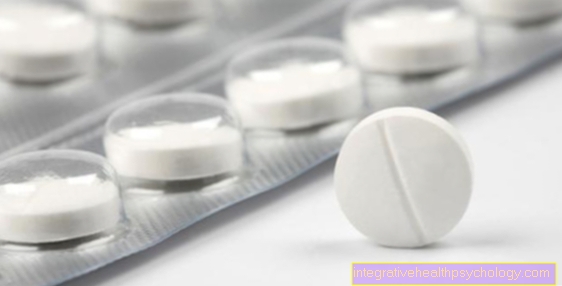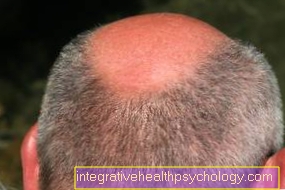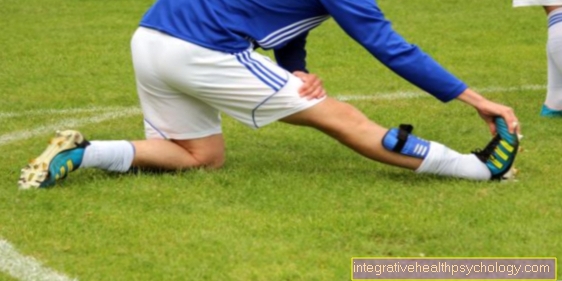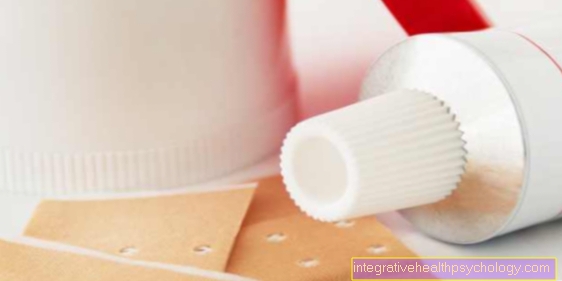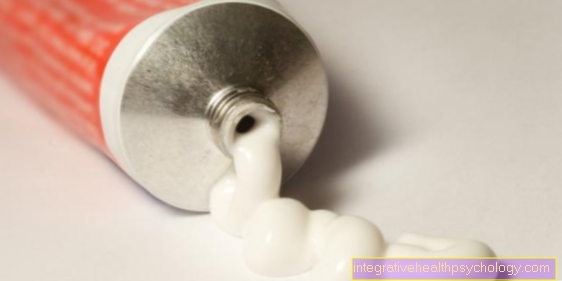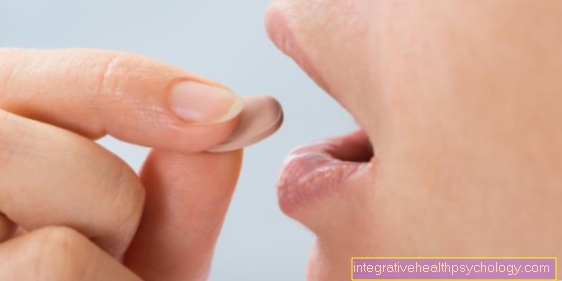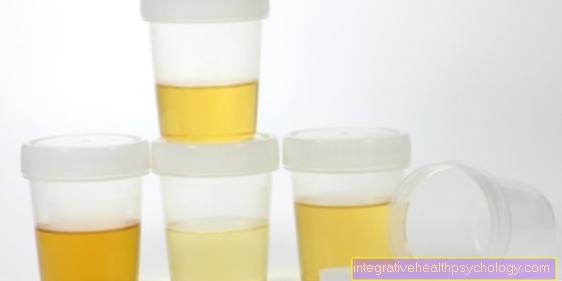Cut
What is a cut?
Cuts are wounds that are mechanically caused by sharp force of any kind. These include above all so-called occasional wounds, which arise accidentally as a result of accidents or deliberately with harmful intent, but also surgical wounds as part of medical interventions (e.g. by scalpels). Occasional wounds are always colonized with germs and therefore tend to become inflamed without adequate treatment. Surgical wounds that are made under sterile conditions are usually sterile and can heal immediately with the formation of a narrow scar (primary wound healing). In all cases, the skin is severed at different depths, with the edges of the wound usually being smooth and, depending on the severity, varying degrees of gap.

causes
Cuts always occur when sharp-edged or pointed objects act mechanically on the skin and sever it. Therefore, the causes that lead to a cut can be varied. Not only knives of any kind can cut the skin, other sharp-edged objects such as glass (broken pieces), edges of paper, razor blades or pointed objects such as nails or needles can cut the skin smoothly.
A distinction must be made, however, whether the object causing the damage accidentally leads to the damage through an "accident" or whether it is used intentionally to cause the damage (by itself or by others).
Diagnosis of a cut
Whether there is a cut is usually a mere visual diagnosis. If an injury has occurred with a sharp or sharp-edged object, a wound is created that in almost all cases has smooth wound edges. Depending on the depth of the incision, the wound edges gape to different degrees.
As a rule, cuts also lead to a very strong pain stimulus, both at the moment of damage and afterwards. This is because the skin is very sensitive (however, the areas of the skin are not equally sensitive in all places because they contain different numbers of nerve endings). In addition, cuts often bleed, depending on the depth and location of the cut.
Complications of a cut
The main complications of a cut are, on the one hand, the penetration of germs into the injured skin and, on the other hand, damage to important structures such as nerves, tendons, muscles or vessels.
In the case of cuts, the protective skin barrier is damaged, so that bacteria get a gateway. This can cause the cut area to become locally inflamed. In the worst case, however, the germs can also spread into the blood and cause a general inflammatory reaction in the form of blood poisoning.
The deeper a wound, the greater the risk that nerves, tendons, muscles and larger blood vessels will be severed. If large blood vessels are injured in deep cuts, profuse bleeding can occur, which can be life-threatening if the initial care is inadequate. The severing of muscles, tendons and nerves can lead to loss of sensation (numbness), restricted mobility and even loss of movement.
How do I recognize an inflamed cut?
Inflammation always occurs when the body or the immune system reacts to harmful stimuli. In the case of a cut, this can either be the damage to the skin itself or the subsequent penetration of bacteria into the injured area.
The body's own reaction then leads to a classic constellation of symptoms: On the one hand, messenger substances that are released by cells of the immune system lead to the expansion of blood vessels in the damaged area of the skin, so that it is better supplied with blood and the area is reddened . The increased blood flow means that more immune cells are transported into the damaged area in order to be able to fight bacteria that have penetrated as efficiently as possible. In addition, the blood vessels become more permeable so that immune cells and blood plasma can pass from the vessels into the surrounding tissue. This usually results in a more or less severe swelling.
The increased blood circulation also makes the corresponding skin area warmer, and the messenger substances also activate certain pain receptors. All in all, an inflamed cut appears red, overheated, swollen and painful, and sometimes functional restrictions (e.g. in movement) can occur.
You might also be interested in: Inflammation of a wound
The festering cut
A cut only festers if the wound becomes infected with bacteria. Pus arises when, on the one hand, certain enzymes of the invading bacteria and the activated defense cells of our immune system break down or melt down proteins in the surrounding tissue and, on the other hand, killed bacteria and dead immune cells accumulate. The mostly yellowish-whitish pus is therefore little more than an accumulation of proteins and cell debris. If a wound festers, it is a sure sign of a bacterial infection and should be treated immediately.
Read more about it: Pus in a wound
Blood poisoning
Blood poisoning is the transfer of germs (bacteria, viruses or parasites) into the blood, mostly via an entry port from the outside - i.e. via injuries to the skin or mucous membrane - or from sources of inflammation in the internal organs (e.g. Appendicitis, abscesses, heart inflammation, etc.). This is the case when an incipient inflammatory reaction is not treated in time.
If a cut becomes increasingly inflamed, the bacteria initially spread in the area of the cut, but in some cases can also get into the bloodstream via surrounding blood vessels and cause blood poisoning. The bacteria then very easily reach all other organs via the bloodstream, especially vital organs such as the heart, liver, kidneys or brain. If you notice symptoms such as fever and chills, increased tiredness, low blood pressure, accelerated breathing and a racing heart after an inflamed cut, you should seek medical advice immediately.
If you would like more information, read more under: Symptoms of blood poisoning
Numbness
A cut usually becomes numb if not only superficial layers of the skin have been severed, but also slightly deeper nerves. If only smaller cutaneous nerves have been severed, the area of skin immediately around the cut may be numb for some time after it has healed, but in many cases the feeling in this area recovers over time. In the case of very deep cuts, which also lead to deep-seated, larger nerve injuries, more serious sensory disturbances can occur. Sometimes these cannot be reversed.
therapy
The correct treatment for a cut depends on the severity or depth of the wound. Smaller, superficial cuts should first bleed a little (to rinse out bacteria and dirt), rinse with clear water and then treated with a sterile plaster. The application of disinfectant is also possible.
Deeper, large cuts should be treated immediately, but the presentation to a doctor should take place as soon as possible so that a possible treatment can be carried out with a suture or a wound adhesive. It is important that the first "bleeding" can reduce the ingress of germs, but of course attention must be paid to blood loss in the case of larger cuts and bleeding.
If it bleeds very heavily, a compression bandage / pressure bandage is indicated for first aid, as well as elevating the affected part of the body until the doctor arrives. In the case of wounds of any kind, tetanus protection is also of great importance and is usually asked by the attending physician: If the vaccination against tetanus was more than 5 years ago or if an immunization against tetanus was never carried out, this must be refreshed or a basic immunization must be given.
You might also be interested in: First aid for wounds
How do you properly disinfect a cut?
In most cases it is sufficient to disinfect the cut once at the beginning. For this purpose, suitable antiseptics should be used that contain the active ingredients octenidine, povidone-iodine or polihexanide. If the wound is already infected with bacteria, it makes sense to disinfect the wound every day until it is symptom-free.
Before disinfectants are applied, the cut should be cleaned with clear water. Then let the wound dry briefly and apply the disinfectant spray or gel and let it take effect. This may be followed by further treatment by the doctor (sewing or gluing); if you are treating smaller, superficial wounds yourself, a sterile plaster should be used.
Read also: Betaisodona® spray
When do I have to see a doctor with a cut?
Superficial cuts that bleed little and that have clean, smooth wound edges that are not wide apart can usually be treated by yourself. However, if the cut is very large, deep, gaping, and bleeding profusely, it should be treated by a doctor.
If there are also sensory disorders or movement disorders in e.g. If you open your fingers, a doctor should be consulted as soon as possible. If a cut is first cared for by yourself and the signs of inflammation or even pus already described here become apparent, this is a possible indication of an infection with bacteria - a doctor should also take a look at the wound here.
When does a cut need to be sewn?
The decision when to sew a cut depends on various considerations: On the one hand, the size, depth and location of a wound play a role.
If the wound is too big or too deep (the wound edges gape too far apart) to heal on its own, the smooth, clean wound edges must be brought together with a suture in order to enable good healing. Especially with cuts in areas that are under great tension (e.g. over joints) or are constantly in motion, suturing is even more useful in order to hold the wound edges together well for healing.
Stitched wounds usually heal more aesthetically with narrower and straighter scars, which is particularly important on parts of the body that play a major role in appearance. Sewing and thus closing cuts also helps to prevent subsequent infections and significantly reduce the risk of infection.
For further information please also read: The skin seam
Can a cut be taped?
The decision as to whether a cut can be glued depends largely on the size, depth and location of the cut. Smaller, less deep wounds are more suitable for gluing. Wound adhesives are often applied as a spray or gel to the skin surface over the wound and thus seal it. Accordingly, it only makes sense if the wound edges do not gape far apart. The use of wound adhesive is also less suitable on areas of skin that are very hairy and areas of skin that are heavily used (e.g. joints). In the case of small cuts, the same cosmetic scar result can often be achieved with adhesives as with a suture, but in comparison it is easier to carry out and much more pleasant for the patient.
When can a cut no longer be sewn?
There is a so-called 6-hour rule in surgery for suturing cuts or wounds in general. The reason why a suture of wounds that are older than 6 hours is as follows: On the one hand, it is assumed that germs have migrated into the wound within the 6 hours. If this wound were then sewn up, the germs would be trapped in the wound area, which increases the risk of wound infection or even subsequent blood poisoning.
On the other hand, the wound edges are, so to speak, "dried up" after 6 hours. If these "old" wound edges are brought together with a suture, the risk that they will not grow back together well increases. This can result in impaired wound healing. Here, however, there is also the option of freshening the wound edges - that is, cutting out the old wound edges under local anesthesia and sewing the fresh wound edges together (secondary suture).
What can you do about the pain?
If a cut is very painful, general pain relievers may be used. The pain is triggered both by the severing of the smallest skin nerves and by the release of messenger substances from the body's own activated immune system, which also activate local pain receptors.
In the course of the process, the area of the body with the cut can be cooled somewhat, which can alleviate the pain. The use of painkillers from the class of non-steroidal anti-inflammatory drugs (NSAIDs) can also be useful: taking ibuprofen, for example, not only has a pain-relieving effect, but also anti-inflammatory at the same time. However, aspirin (ASA) should not be taken as a pain reliever, as this pain reliever also causes the blood to be “thinned”, which can lead to increased bleeding of the cut.
Healing time of a cut
The time it takes for the wound to heal depends on whether the wound edges of the incision grow together directly to form a narrow scar (primary wound healing) and whether there are any healing complications. In the case of a normal, uncomplicated course without wound infection, in the case of a wound in which the wound edges grow together either on their own or through a well-adapted suture, the healing usually takes about 7-10 days. From the 7th / 8th On the day of wound healing, a skin scar begins to form. In the case of superficial incisions, in which only the epidermis is severed, however, healing without scars is possible.
You might also be interested in: Scar Care
Recommendations from our editorial team
Topics that may also interest you:
- Wound healing
- First aid for wounds
- Laser scars
- The Bepanthen® scar gel
- Stab wound
- Bruises
- Lacerated wound
- Laceration








